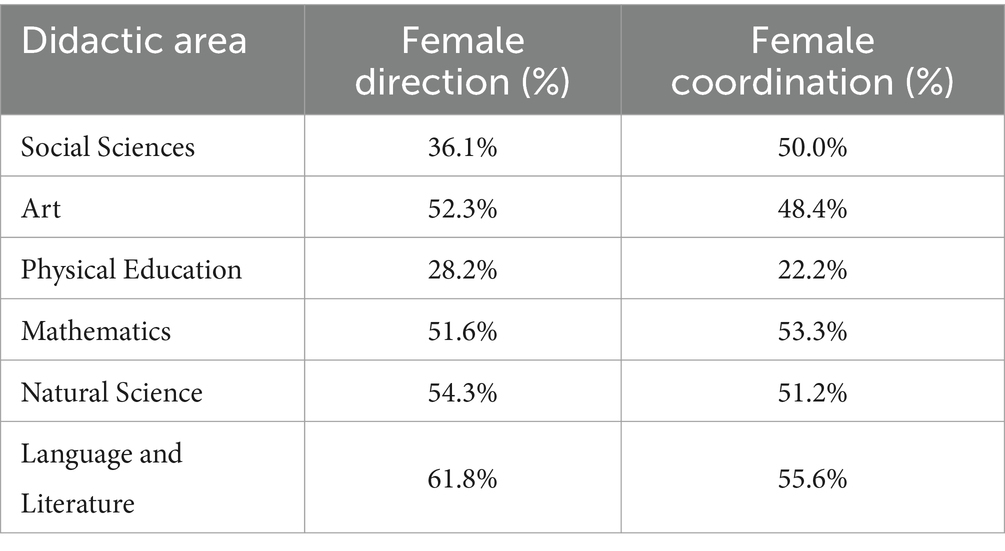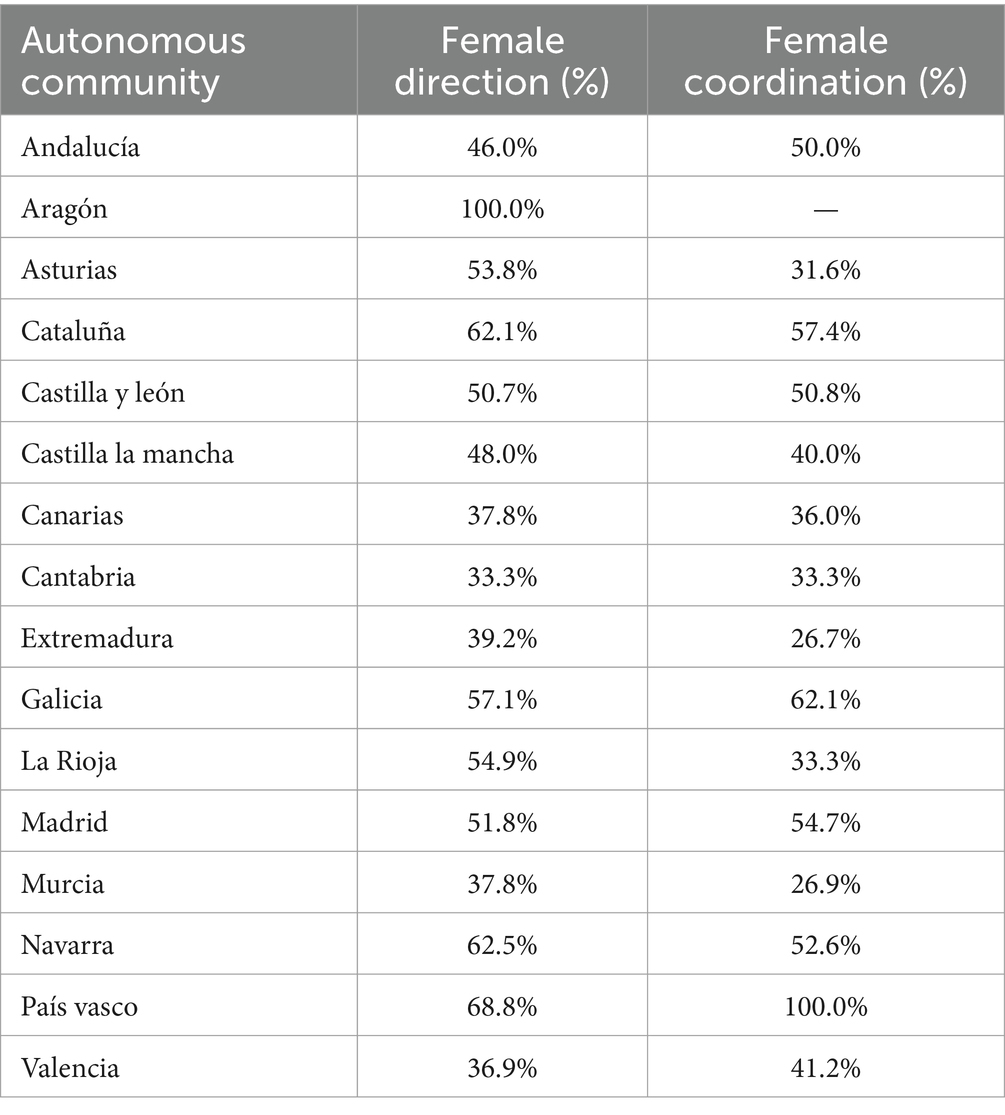- 1Faculty of Education and Sports, University of Deusto, Bilbao, Spain
- 2Institute for Multidisciplinary Research in Science and Technology, University of La Serena, La Serena, Chile
- 3University of Deusto, Bilbao, Spain
This study examines the role of women in the academic and scientific domains, emphasizing the need for institutions to ensure women’s representation for an equitable system. We analyzed 794 syllabi from the Primary Education Degree within the Spanish University Network using a qualitative-comparative approach, focusing on women’s involvement in the management and coordination of courses and their representation in the associated bibliographic materials. The findings reveal a predominantly androcentric environment, where, despite women’s active participation in course leadership, their contributions to the bibliographic landscape are significantly limited. The research highlights the disparities in gender representation and underscores the necessity for measures to enhance women’s visibility in academic and scientific spaces.
1 Introduction
One of the many challenges facing 21st-century societies revolves around reducing the gender-based inequity gap. This fact is not lost in the university educational reality and undoubtedly represents an element to address for all individuals involved in the academic sphere (Velasco et al., 2024). Indeed, some authors have highlighted the presence of sexist attitudes in this social reference space (Navarro-Pérez et al., 2019; Subirats, 2019; Fernández et al., 2022). In this regard, Maffía (2007) establishes a typological framework defining these attitudes in four different expressions: lack of recognition of scientific contributions, unequal professional positioning, a culturally biased biological conception regarding their physical, emotional, and psychological nature, and finally, a displacement of scientific rigor.
More specifically, in higher education, women face various challenges. For example, even though there are now more women in higher education than ever before, they do not appear to have the same opportunities as their male colleagues. In fact, the more senior the grade, the lower proportion of female academics in the grade. Furthermore, women in higher education make up 13% of professors in old universities, with success highly dependent on subject. In addition, leadership as a challenge for women in higher education. Accordingly, gender limits women in higher education (Cotterill and Letherby, 2005; Maphalala and Mpofu, 2017). It seems evident, therefore, that androcentric culture exerts multifaceted effects within the university and scientific context, precisely through symbolic constructions about men and women (González and Delgado, 2016), perpetuating a model that solidifies a collective imaginary where the male figure prevails over the female.
All of this occurs despite the gender equality principle (GEP) being enforced not only by various international bodies (UN Women, 2015) but also by European and state educational and ordinary legislations (see Organic Law 3/2007, Royal Decrees 1393/2007, 861/2010, and the currently effective Royal Decree 822/202). Studies reveal the dominance of men in the norms and values determining and hierarchizing roles in the academic space (Becher, 2001; Mestre and Guil, 2004), operating as polarizers in academic duties both in teaching and research (Berrios, 2005; Maffía, 2007).
In this scenario, it becomes evident that both academic institutions and all involved parties must ensure an equitable system of relationships to provide formative outcomes that guarantee the inclusion of social and civic principles (Fernández, 2011). Presently, there exists an academic genre that allows visibilizing how women are positioned in various activities involving tasks both in teaching and scientific representation: the teaching guide (TG).
The TG is a highly rigorous document in its execution, published after review by different academic bodies and endorsed by various competent bodies in university institutions (Delgado and De Justo, 2018). This genre constitutes a publicly available document aiming to unfold all necessary information for monitoring a subject in the teaching action of an academic degree. Among this information, its sections deploy, in addition to the entire curriculum base of a subject, basic data of the faculty in charge of its direction or coordination, as well as all bibliographic information provided for student theoretical training.
Ultimately, the TG becomes a suitable instrument to contrast the visibility granted to women both in the teaching and scientific realms. Primarily, this document allows analyzing the bibliographic production displayed in the subjects. This element is of special interest as it has been scarcely studied, as revealed by the literature (García-Jiménez, 2021). Furthermore, it permits placing the relevance of women in theoretical training or, in other words, the place occupied by scientific production generated by women. Secondly, the approach to said scientific production offered through the bibliography in university training subjects allows identifying whether the GEP is taken into account in the students’ theoretical training. In this case, no contributions regarding this aspect were found in the reviewed literature. This is considered a fundamental element as it would identify the level of acceptance of the GEP among university faculty. Finally, the TG allows visibilizing the representation of women in the direction and coordination of university subjects, as one of its sections deals with identifying the faculty responsible for each subject.
As previously noted, studies analyzing the framework of symbolic relationships and the prestige and power system between men and women in different academic disciplinary communities are scarce (Sánchez, 2011). Approaches exist from the disciplinary field of sociology (Lengermann and Niebrugge, 2007) as well as from the realm of communication (García-Ramos et al., 2020; García-Jiménez, 2021; García-Jiménez and Simonson, 2021; García-Jiménez et al., 2022; García-Jiménez and Herrero, 2022). This research aims to contribute to visualizing the situation of women in the disciplinary space of Education and more specifically in the Primary Education (PE) Degree area.
In this framework, the study aims to determine the presence of women in the development of subjects within the PE Degree in the Spanish University Network (SUN)based on the variables: disciplinary context, autonomous community (AC), and type of ownership.
The overarching goal of our research is further delineated into the following specific objectives:
1. Determine the presence of women in the bibliographic production declared in the TGs of the PE Degree in the SUN.
2. Identify the inclusion of the GEP in the bibliographic production declared in the TGs of the PE Degree in the SUN.
3. Determine the presence of female teachers in the direction or coordination of the subjects in the PE Degree in the SUN.
2 Method
For this purpose, a qualitative research approach has been developed, addressing the study of a corpus composed of 794 TGs.
This study was conducted using a qualitative, descriptive, and comparative method, displaying generalizable and representative results of the selected population (Hernández et al., 2006). Additionally, it is a non-experimental investigation, given that the variables have not been manipulated but are integrated into the research and have already exerted their effects (Sierra, 2007).
2.1 Corpus
The corpus formation began with the analysis of the curriculum of the 68 Spanish universities offering the PE Degree during the academic year 2020–2021. Three of these universities were excluded as they did not have public TGs, resulting in a total of 65 universities for the analysis. Subsequently, inclusion and exclusion criteria were defined for the final corpus formation. Therefore, included in the corpus were those universities offering the Primary Education Degree and possessing TGs for the academic year 2020–2021. Additionally, the TGs had to belong to specific didactic subjects and be written in Spanish. Conversely, excluded were TGs belonging to Double Degrees or postgraduate courses, those from previous academic years to 2020–2021, those referencing technical subjects or purely declarative knowledge, and those written in English, French, Basque, Galician, or Catalan.
Initially, a total of 842 SGs were reported, but 51 were excluded after applying the described criteria. Thus, ultimately, a corpus of 794 SGs was obtained (93.4% of the total), divided as follows: pilot corpus (40 SGs), test corpus (222 SGs), and general corpus (532 TGs). Each was registered with a unique identifier code that included information about the autonomous community it belonged to, the university ownership, document number, and the didactic area it corresponds to (for example: PV_P_01_Q).
The following graph (Figure 1) illustrates the final composition of the analyzed corpus.
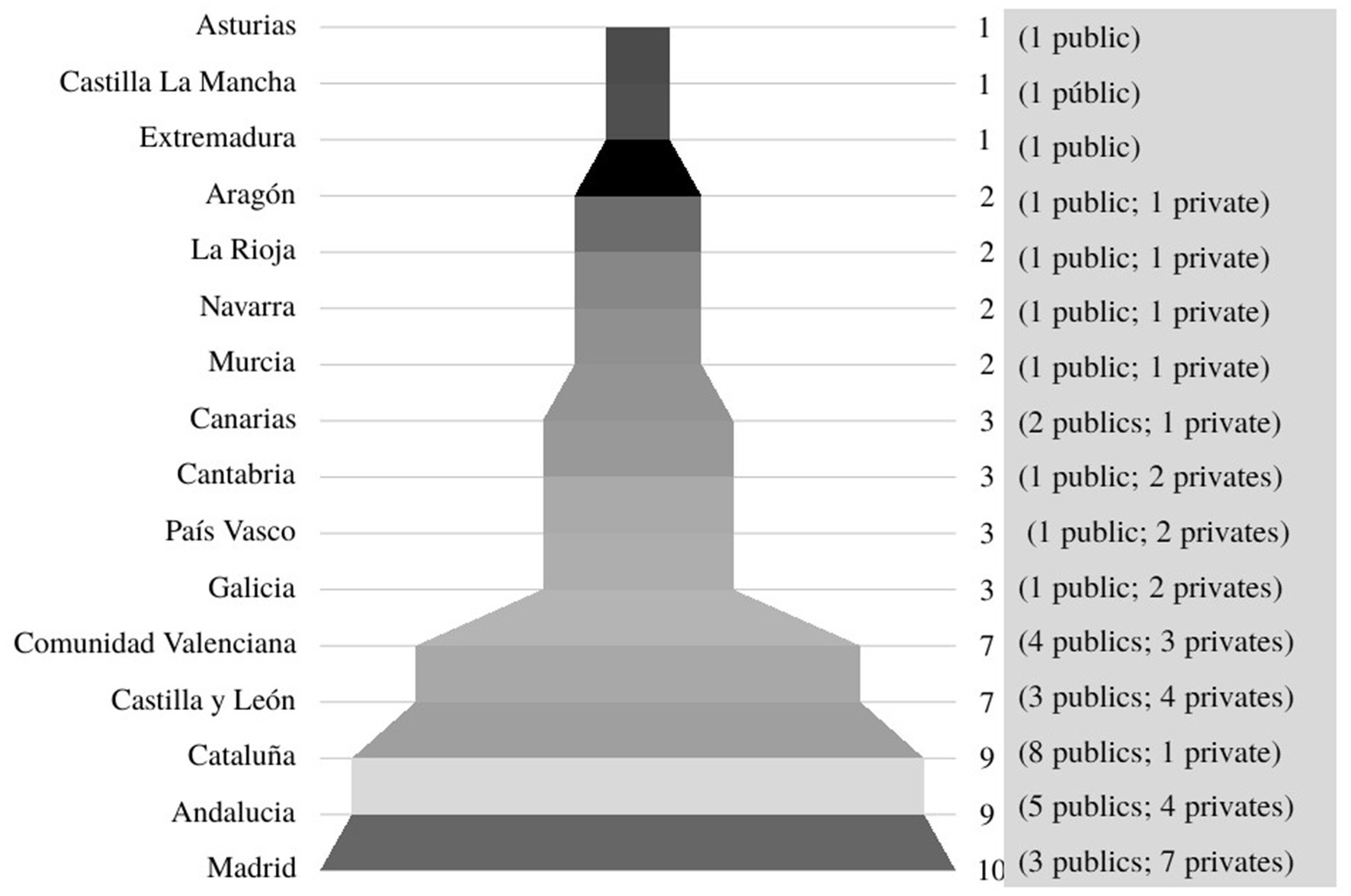
Figure 1. Corpus of the Spanish universities participating in the study by autonomous community and ownership.
2.2 Instrument development
Firstly, analysis categories were established to explore the presence of women in the bibliographic production of the TG, the inclusion of GEP in those guides, and women’s involvement in leading or coordinating subjects. Categorization was conducted by collecting data on the authorship of the bibliography (female, male, or neutral if gender identification was impossible) and the presence of gender equality in the thematic content of the proposed documents. Regarding the analysis instrument, its development process followed several phases: initially, each researcher coded and labeled a small sample of TGs (5% of the total). Subsequently, triangulation was conducted based on the collected data. Codes that raised doubts were noted, and then the resources and provisional labeling for the analysis were collaboratively outlined. Next, there was a consultation with experts in language and gender issues to evaluate the reliability of the defined categories for corpus analysis. At this stage, experts proposed adjustments in the theoretical definition of some categories. Further validation involved analyzing a test subcorpus (28%), followed by an expert judgment process involving two Spanish experts and one from Chile. An Excel template was created for the experts to indicate the agreement, relevance, and clarity of each defined category with a “yes” or “no.” The level of agreement among evaluators was calculated using Fleiss’ Kappa test (K = 0.72), indicating a considerable degree of agreement.
2.3 Analysis procedures
Data were collected on individuals responsible for leading and coordinating the TGs. Subsequently, the documents were analyzed based on the established categories: (1) rate of female and male authorship in the bibliographic references included in the TGs, (2) rate of bibliographic references addressing gender equality, (3) rate of female and male representation in subject leadership, and (4) rate of female presence in subject coordination.
It’s noteworthy that Microsoft Excel was utilized for the corpus analysis, recording the data corresponding to each category in the analyzed TGs.
3 Results
The results obtained after analyzing the 794 TGs comprising the corpus are presented below, organized into two sections. The first section provides the results related to the analysis of the proposed bibliography within the TGs (presence of women and inclusion of the GEP in the bibliographic production), while the second addresses issues regarding their coordination and management. Everything based on the three previously mentioned variables: disciplinary context, autonomous community, and type of ownership.
3.1 The analysis of the proposed bibliography within the TGs
Firstly, it is pertinent to note that in 53 of the analyzed TGs, there is no section dedicated to bibliographic references. Therefore, in this part of the analysis, the remaining 741 have been considered.
According to the data, it is possible to assert that in the proposed bibliography within these TGs, the number of identified male authors is significantly higher—almost double—compared to female authors (62.41 and 33.21%, respectively).
If these general data are analyzed based on each of the didactic areas considered in this research, the results are presented in Table 1.

Table 1. Percentage of female, male and neutral authorship in the proposed bibliography by didactic area.
These data indicate, that there is a common trend across all considered didactic areas: male-authored bibliography clearly prevails over female and neutral authorship. Nevertheless, certain areas stand out prominently. This is the case, for instance, in Physical Education and Social Sciences, where the number of male authors triples that of female authors. In the rest of the considered areas, the proportion of female authorship ranges between 35.4 and 43.1%. It is worth mentioning that, although the percentage is lower than that of male authorship in all cases, the situation of Language and Literature stands out, presenting the highest frequency of female authorship (43.1%).
When conducting the analysis by AC, the results obtained are presented in Table 2.
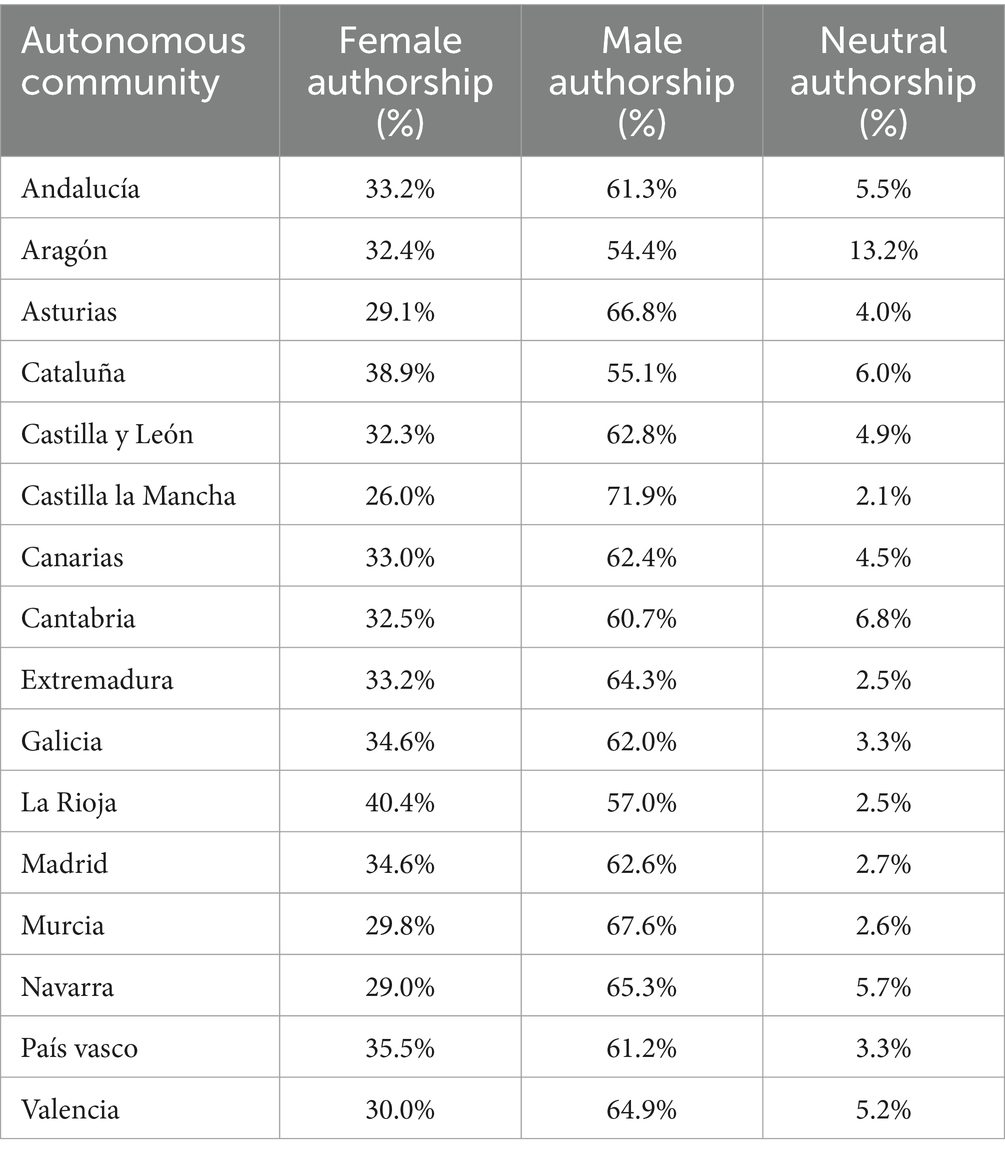
Table 2. Percentage of female, male and neutral authorship in the proposed bibliography by autonomous community.
As seen, TGs from all ACs exhibit a higher rate of male authorship. This difference is particularly pronounced in the case of the Castilla La Mancha communities, where the rate of male authorship is almost triple that of female authorship. A similar scenario occurs in Asturias, Murcia, Navarra, and Valencia, where there are also more than twice as many male authors as female authors. In contrast, Catalonia and La Rioja are the communities where there is the least difference between the number of female and male authorships (16.2 and 16.6%, respectively).
Next, in Table 3, the results obtained for the percentage of female, male, and neutral authorship are systematized in relation to the third variable considered in this research, namely, the ownership of higher education institutions.

Table 3. Percentage of female, male and neutral authorship in the proposed bibliography by ownership.
Indeed, there are no differences between the results obtained in private and public universities. In both cases, the rate of female authors corresponds approximately to one-third of the total proposed authors (32.7% in the case of public and 34.2% in the case of private institutions).
Regarding the visibility of the gender equality principle in the proposed bibliography, Table 4 presents the different results for each of the analyzed didactic areas.
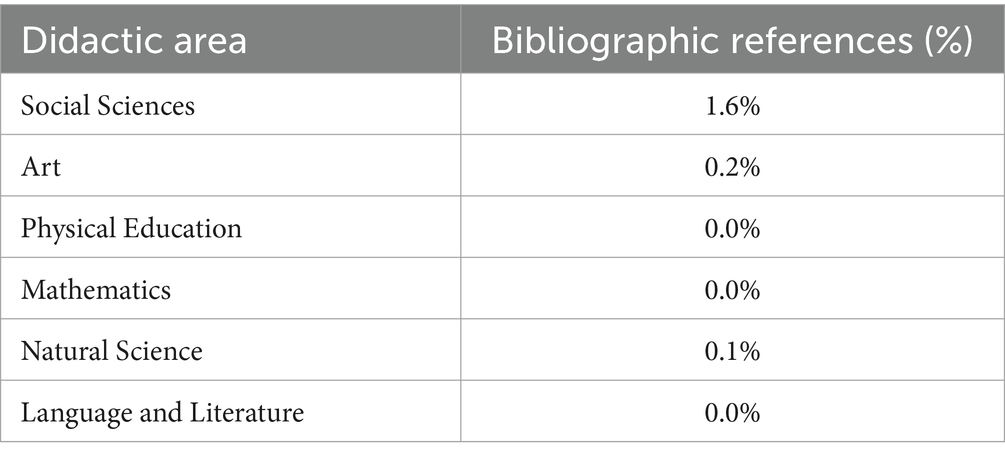
Table 4. Percentage of proposed bibliographic references that make visible productions related to gender equality in each didactic area.
Only a few proposals related to gender equality have been found. On this occasion, Social Sciences is the area that presents the highest percentage of proposals related to gender equality. In the rest of the studied didactic areas, the outlook is even more pessimistic, as there are hardly any proposals related to gender equality included.
Table 5 presents the same results obtained, this time considering the AC variable.
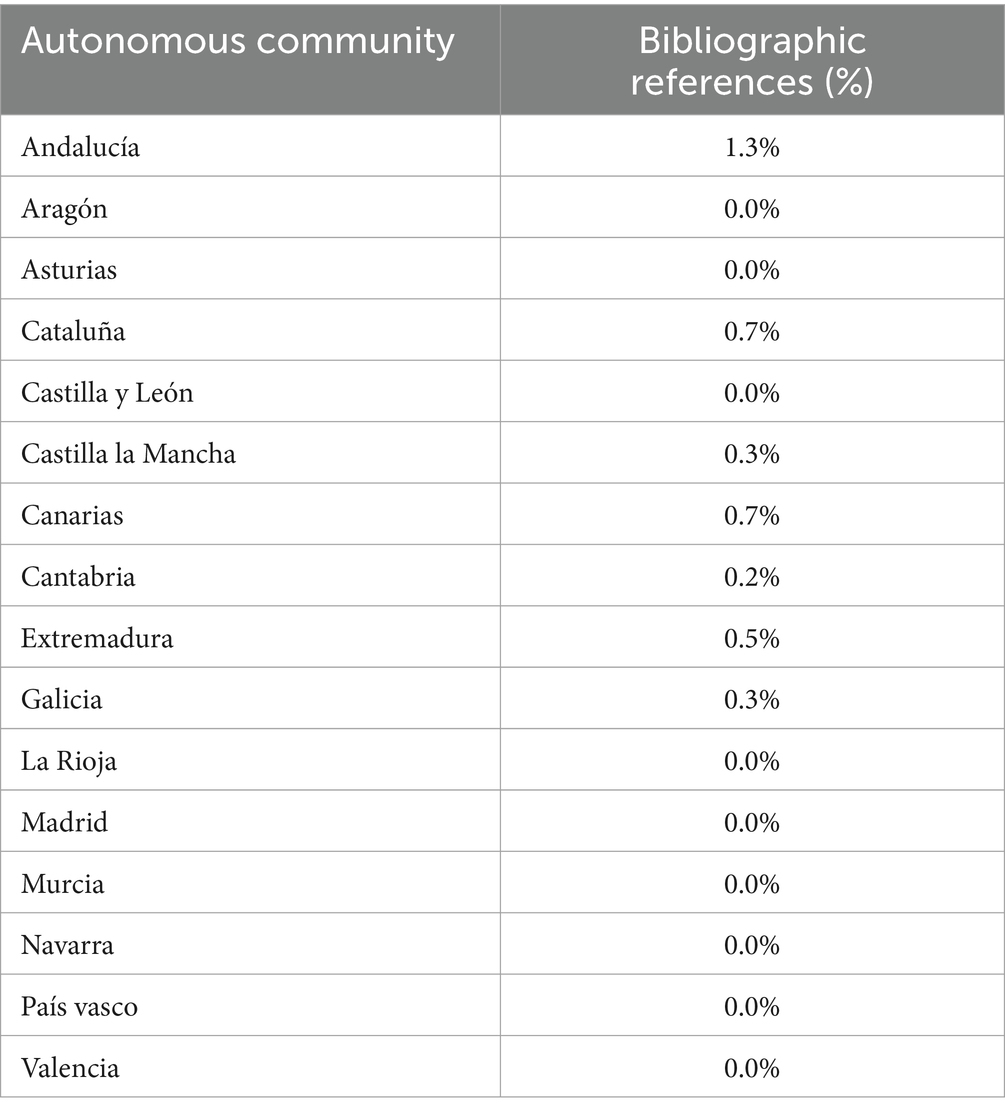
Table 5. Percentage of proposed bibliographic references that make visible productions related to gender equality in each autonomous community.
As it was the case with the didactic areas, the bibliography that highlights gender equality is almost non-existent in all Autonomous Communities. In this context, Andalusia is the community with the most bibliographic proposals referring to that concept (1.3% of the bibliographic proposals).
Finally, Table 6 presents the results related to the frequency of bibliographic references highlighting productions related to gender equality according to the ownership variable.

Table 6. Percentage of proposed bibliographic references that make visible productions related to gender equality by ownership.
As the data shows, very few guides present bibliography that highlights the topic of gender equality. Additionally, all of them belong to public universities, and none to private institutions.
3.2 Analysis of the direction and coordination of the teaching guide
Another aspect analyzed in this research is the direction and coordination of subjects in the Primary Education Degree in the Higher Education Institution. As mentioned, the direction refers to each teacher who teaches the subject and edits the corresponding aspects in the Teaching Guide. The number of people responsible for the direction varies in each case. Regarding coordination, however, this task always falls to a single person, who may or may not be a teacher of the subject.
In general terms, the data shows that 47.4% of subject directions are held by women. Similarly, in the case of coordinations, there are also high percentages of female coordinators (46.3% of the total). To further break down this general result according to the different variables included in this study, Table 7 presents the results by didactic area.
In Table 7, it can be observed that Physical Education and Social Sciences are the areas with the lowest rate of female direction (28.2 and 36.1%, respectively). Conversely, Language and Literature is the area where the highest presence of female directors is observed (61.8%). In the case of Physical Education, the data is particularly low. Regarding the coordination of Teaching Guides, only in the area of Physical Education does female coordination (22.22%) not surpass male coordination (78.78%).
On the other hand, it’s worth noting the case of Social Sciences, one of the areas that shows lower presence both in terms of subject directors and authors in the proposed bibliography, yet it presents a 50% female coordination.
Table 8 presents the results of female representation in the direction and coordination of subjects according to the Autonomous Community (AC) variable.
As depicted in the table, only in seven Autonomous Communities, female direction of subjects is lower than male direction: Andalusia (46%), Castilla la Mancha (48%), Canary Islands (37.8%), Cantabria (33.3%), Extremadura (39.2%), Murcia (37.8%), and Valencia (36.9%). In the rest of the communities, female direction is higher than male direction, highlighting the case of Aragon, where the percentage of female direction is 100%.
Regarding the coordination of subjects, this time, there are seven communities in which coordination is held by a woman in at least half of the cases: Andalusia (50.00%), Catalonia (57.4%), Castilla y León (50.9%), Galicia (62.1%), Madrid (54.7%), Navarra (52.6%), and Basque Country (100%). It’s worth highlighting the latter, the Basque Country, where all subject coordinations belong to women.
Finally, in Table 9, the results regarding the direction and coordination of subjects related to the ownership variable are presented.
In terms of ownership, this time, there are also no major differences between public and private universities, as evidenced by the data presented in Table 9. As seen, both in public and private universities, there is approximately 48% female direction in specific didactic subjects. In the case of coordinations, there is a slight increase in the percentage of Teaching Guides coordinated by a woman in private universities (49.5%) compared to public ones (45.9%).
4 Discussion
The results regarding the analysis of the bibliography provided in the TGs, which show a bibliographic compilation where male authorship almost doubles the rate of female authorship, evidence a clear androcentric tendency also identified in other studies (Lengermann and Niebrugge, 2007; García-Ramos et al., 2020; García-Jiménez, 2021; García-Jiménez and Simonson, 2021; García-Jiménez et al., 2022). These data, in turn, demonstrate that the knowledge transmitted in the Primary Education Degree of the Higher Education Institution is mainly based on the contributions of male authors. The low proportion of female authorship confirms, on the one hand, the undervaluation of women as authors in the construction of knowledge (Maffía, 2007) and, on the other hand, that the training of Primary Education students is materializing through the invisibility of these women.
This is worrisome, as it constructs an educational interpretation of future Primary Education teachers based on a clear bias against the recognition of women. In this line, research in recent years (Arias, 2016) states that the incorporation of bibliography by female authors in TGs is fundamental to establish the importance of women in various historical moments and sociocultural conditions, moving away from the construct that depicts women as exceptional individuals unrelated to social processes and structures. In this sense, the incorporation of a higher rate of bibliography by female authors in the Teaching Guides of Primary Education could contribute to students accessing a less biased, and male-centric, view of the different topics addressed during their academic formation.
Accordingly, the analysis carried out concerning the didactic area variable allows for the visibility of that reality within the scientific realm. Despite a low representation of the principle of equality and female authorship, it’s interesting to note how humanistic areas such as Social Sciences, although showing a higher presence of female authorship as seen in other works (Montané and De Carvalho, 2012) and inclusion of the gender equality principle (Aguilar, 2015; Díez et al., 2016; Moreno and Díez, 2018; Ortega and Pagés, 2018; Velasco et al., 2024), evidence that education within this area is clearly androcentric and therefore biased.
The analysis of the autonomous community and ownership variables affirms that the presence of female authors is very limited, resulting in a lack of recognition of their achievements and contributions in the content covered in various subjects. Consequently, female cultural references are poorly represented in the materials used to educate students within the Spanish University Network. Therefore, with this low presence of female authorship references, it’s not surprising that, as López and Querol (2014) point out, there is a collective belief that women have hardly contributed to social and cultural development. Higher education institutions play a crucial role in debunking this belief. One way to do this would be through gender parity in the bibliography used to educate students.
Once again, similar to the inclusion of female authorship, the inclusion of the gender equality principle in the bibliography content is very low. The analysis of the variables yields results very similar to those shown in the inclusion of female authorship in the bibliographic proposal. Thus, regarding the disciplinary area variable, once again, the Social Sciences area shows the greatest display despite its low inclusion ratio. Similarly, the autonomous community and ownership variables again show very low appearance rates, and it also confirms what was mentioned earlier, asserting that there is no ideological-political pattern.
Ultimately, there is clear underrepresentation of women in the bibliography, as well as a lack of deployment in the content of the gender equality principle. This is a widespread fact, regardless of the didactic areas, the Autonomous Community, or the type of institution taken into account. This non-equitable female representation undoubtedly contributes to perpetuating gender gaps existing in academia, as well as causing a gender bias in the Primary Education stage where women are clearly left behind.
Another aspect analyzed in this research is the direction and coordination of subjects in the Primary Education Degree within the SUN. Considering that, according to data collected in the academic year 2016/2017 by the Ministry of Education and Vocational Training, 41.3% of university teaching staff are women (Ministry of Education and Vocational Training, 2019), it could be asserted that the percentage of female university professors in didactic subjects in the Primary Education Degree in the SUN is higher than the average. In this regard, high percentages of coordination are also observed (46.3% of the total).
Regarding the didactic area variable, it’s notable that Physical Education demonstrates the lowest ratio. This could be attributed to the historically low presence of women in this area and the fact that, although by the end of the 20th century women had gained visibility in this context, the sports environment remains predominantly male (Pérez-Ugena, 2020), resulting in a very limited space for women in this field (Piedra et al., 2013).
Considering these results and those presented in the previous section, a significant relationship emerges. There seems to be a connection between the direction of a subject and the proposed bibliography. Specifically, lower female direction corresponds to a lower rate of female authorship in the proposed bibliography. Therefore, the results suggest that having more female directors in subjects could lead to the inclusion of a higher amount of female-authored bibliography in Teaching Guides. In this regard, subject directors might be more conscious about the importance of incorporating a significant amount of female bibliography in the Teaching Guides. This finding is highly relevant, allowing universities, for instance, to take concrete actions to enhance the visibility of women in the education they provide.
To conclude, it’s relevant to mention that the absence or lack of representation of women in different aspects of Teaching Guides and, consequently, in university education, has significant repercussions. This positions women as second-class citizens, leading to an undervaluation of their contributions in the academic sphere and society at large. Furthermore, the exclusion of women from the discourse conveyed in educational content, through Teaching Guides, represents an unacceptable lack of rigor (López and Querol, 2014). On the other hand, it transforms Teaching Guides into instruments perpetuating inequalities.
5 Conclusion
The main objective of this study was to determine the presence of women in academic-university education in the Primary Education Degree within the Spanish University Network (SUN) concerning disciplinary context, Autonomous Community (AC), and type of ownership variables. Firstly, the results indicate a clear predominance of male authorship over female authorship in the proposed bibliography within Teaching Guides (TG), regardless of the didactic area, AC, or type of ownership. There are slight variations in the rate of female authorship in some didactic areas (for example, in the Social Sciences area or in Physical Education compared to Language and Literature) or between some communities (Navarra versus La Rioja), but in none of the cases does the rate of female authorship equal that of male authorship. This reflects an evident androcentric view, where women’s productions in the academic sphere are invisibilized (Maffía, 2007). This impacts the training of future teachers in the sensitive stage of Primary Education, fostering bias and clear exclusion of women in these contexts. The perpetuation of these gender biases is especially relevant in teaching practices as they reinforce the gender system and, therefore, inequality both in the classroom and in society (Díaz de Greñu and Anguita, 2017).
Additionally, the inclusion of the Gender Equality Principle (GEP) in the proposed bibliographic production within the TG of subjects is minimal based on the obtained results, where no significant rate was found in any case. This is particularly striking in the case of Social Sciences, which, while presenting a slightly higher rate than other didactic areas, remains surprisingly low (1.6%), despite being considered an area of reference in social pattern creation (López and Querol, 2014).
Moreover, the CA variable does not show significant differences. Although Andalucía is the community that most visualizes the GEP in its proposed bibliography, it is still almost non-existent (1.3%). Therefore, there are no clear ideological or geographical patterns regarding the inclusion of the GEP.
The same applies to the ownership variable. In this case, all universities that highlight the GEP in their proposed bibliography are public universities, but the rate obtained (0.5%) is not sufficient to make any generalizations regarding the inclusion of the GEP. However, although the proposed bibliography in the guides yields rather disheartening results in terms of female authorship or the GEP, it’s worth mentioning that the results are more positive when analyzing the presence of women in the direction or coordination of didactic subjects in the Primary Education Degree within the SUN.
In view of these results, it’s striking that, despite the high rates of female direction and coordination in almost all cases, the analysis of the proposed bibliography in the TG does not show more positive outcomes. Nevertheless, there seems to be a relationship between the rate of direction or coordination of subjects and female presence in the bibliography; that is, a higher female presence in management positions correlates with a higher female presence in the proposed bibliography within the GD of subjects. For instance, consider the case of Language and Literature, where the rate of female authorship in the proposed bibliography was the highest among all analyzed didactic areas (43.1%) and also had the highest rates of direction and coordination (61.8 and 55.6%, respectively). In summary, while the presence of women is quite similar to that of men in management positions of didactic subjects in the Primary Education Degree within the SUN, there is still much progress needed in terms of the visibility of women and gender equality.
Limitations of this study include the inability to access all universities within the spectrum of the Primary Education Degree in the SUN (65 out of 68). Additionally, it would have been interesting to cross-reference the TG data with the participation of stakeholders related to the analyzed gender (department heads and faculty). In this regard, future enriching this study with other qualitative techniques is projected.
On the other hand, the strengths of this work lie in the following aspects. Firstly, the consideration of two variables that have allowed for the analysis of specific aspects and undoubtedly open avenues for new research spaces. Secondly, the study focuses on an extraordinarily necessary topic, namely the analysis of discriminations and, in particular, the discriminatory reality experienced by women. This is accentuated in the academic and scientific spheres, where androcentric construction patterns prevail, as evidenced from both the literature and the data in this study. In conclusion, this study provides solid and valuable results that allow us to continue advancing towards the recognition of women compared to men.
Data availability statement
The original contributions presented in the study are included in the article/supplementary material, further inquiries can be directed to the corresponding author.
Author contributions
JH-R: Conceptualization, Formal analysis, Methodology, Resources, Supervision, Writing – original draft, Writing – review & editing. PM: Conceptualization, Formal analysis, Methodology, Resources, Writing – original draft, Writing – review & editing. EV: Conceptualization, Formal analysis, Methodology, Resources, Writing – original draft, Writing – review & editing.
Funding
The author(s) declare that no financial support was received for the research, authorship, and/or publication of this article.
Conflict of interest
The authors declare that the research was conducted in the absence of any commercial or financial relationships that could be construed as a potential conflict of interest.
Publisher’s note
All claims expressed in this article are solely those of the authors and do not necessarily represent those of their affiliated organizations, or those of the publisher, the editors and the reviewers. Any product that may be evaluated in this article, or claim that may be made by its manufacturer, is not guaranteed or endorsed by the publisher.
References
Aguilar, C. (2015). Igualdad, género y diversidad sexual en la Formación Inicial de Maestro/a en la Universidad Jaume I (UJI). Temas Educ. 21, 77–96, Available at: https://revistas.userena.cl/index.php/teduacion/issue/view/83
Arias, A. C. (2016). Las mujeres en la historia de la ciencia argentina: una revisión crítica de la bibliografía. Trabajos Comun. 43, 1–16, Available at: https://www.bibliotecafragmentada.org/las-mujeres-en-la-historia-de-la-ciencia-argentina/
Becher, T. (2001). Tribus y territorios académicos. La indagación intelectual y las culturas de las disciplinas. Barcelona: Gedisa.
Berrios, P. (2005). El sistema de prestigio en las universidades y el rol que ocupan las mujeres en el mundo académico. Calid. Educ. 23, 349–361. doi: 10.31619/caledu.n23.301
Cotterill, P., and Letherby, G. (2005). Women in higher education: issues and challenges. Women’s Stud. Int. Forum 28, 109–113. doi: 10.1016/j.wsif.2005.04.001
Delgado, A., and de Justo, E. (2018). Evaluación del diseño, proceso y resultados de una asignatura técnica con aprendizaje basado en problemas. Educación XXI 21, 179–203. doi: 10.5944/educXX1.19415
Díaz de Greñu, S., and Anguita, R. (2017). Estereotipos del profesorado en torno al género y a la orientación sexual. Rev. Electron. Interuniv. Form. Profr. 20, 219–232. doi: 10.6018/reifop/20.1.228961
Díez, R., Aguilar, B. M., Gómez, I. M., Lozano, I., Iglesias, M. J., Pérez, T., et al. (2016). “Inclusión de la perspectiva de género en las guías docentes de asignaturas de Didáctica” in XIV Jornadas de Redes de Investigación en Docencia Universitaria: Investigación, Innovación y Enseñanza Universitaria: Enfoques Plurimultidisciplinares, ed. Universidad de Alicante (Alicante, Spain: Instituto de Ciencias de la Educación), 2665–2679.
Fernández, A. (2011). La evaluación orientada al aprendizaje en un modelo de formación por competencias en la educación universitaria. Rev. Docencia Univ. 8, 11–34. doi: 10.4995/redu.2010.6216
Fernández, P., Jaureguizar, J., and Idoiaga, N. (2022). Análisis del sexismo y feminismo en el futuro profesorado. Hum. Rev. 11, 1–14, Available at: https://journals.eagora.org/revHUMAN/article/view/4317/2681
García-Jiménez, L. (2021). Aportaciones femeninas a las teorías de la comunicación: Una propuesta para la docencia y la ciencia. Anàlisi: Quaderns de Comunicació i Cultura, Barcelona 65, 121–135. doi: 10.5565/rev/analisi.3327
García-Jiménez, L., and Herrero, E. (2022). Narrating the field of communication through some female voices: Women’s experiences and stories in academia. Commun. Theory 32, 289–297. doi: 10.1093/ct/qtac002
García-Jiménez, L., and Simonson, P. (2021). Roles, aportaciones e invisibilidades femeninas en el campo de la investigación en comunicación. Rev. Mediterr. Comun. 12, 13–15. doi: 10.14198/MEDCOM.20163
García-Jiménez, L., Torrado-Morales, S., and Díaz-Tomás, J. M. (2022). El rol de la mujer en la ciencia y la docencia en comunicación: análisis a partir de los programas universitarios en España. Rev. Comun. 21, 91–113. doi: 10.26441/RC21.2-2022-A5
García-Ramos, F. J., Zurián, F. A., and Núñez-Gómez, P. (2020). Los estudios de género en los Grados de Comunicación. Comunicar: Revista científica iberoamericana de comunicación y educación, Huelva 28, 21–30, Available at: https://dialnet.unirioja.es/servlet/articulo?codigo=7304124
González, M. C., and Delgado, Y. (2016). Lenguaje no sexista: una apuesta por la visibilización de las mujeres. Comunidad y Salud 14, 86–95, Available at: https://www.redalyc.org/pdf/3757/375749517011.pdf
Hernández, R., Fernández, C., and Baptista, P. (2006). Metodologia de la investigación. Naucalpan de Juárez: McGraw-Hill.
Lengermann, P. M., and Niebrugge, G. (2007). The women founders: sociology and social theory 1830–1930. Long Grove, IL: Waveland Press.
López, A., and Querol, M. (2014). Las escritoras ausentes en los manuales: propuestas para su inclusión. Didáctica, Lengua y Literatura 26, 217–240, Available at: https://revistas.ucm.es/index.php/DIDA/article/view/46840/43952
Maffía, D. (2007). Epistemología feminista: La subversión semiótica de las mujeres en la ciencia. Revista Venezolana de Estudios de la Mujer 12, 63–98, Available at: http://ve.scielo.org/scielo.php?script=sci_arttext&pid=S1316-37012007000100005
Maphalala, M., and Mpofu, N. (2017). Are we there yet? A literature study of the challenges of women academics in institutions of higher education. Gender Behav. 15, 9216–9224.
Mestre, J. M., and Guil, R. (2004). Violencia escolar: su relación con las actitudes sociales del alunado y el clima social del aula. Rev. Electrón. Iberoam. Psicol. Soc. 1:1.
Ministerio de educación y Formación Profesional (2019). Las mujeres representan la mayoría del profesorado y de los cargos directivos en la enseñanza no universitaria. Available at: https://www.educacionyfp.gob.es/prensa/actualidad/2019/03/20190403-aulasigualdad.html
Montané, A., and De Carvalho, M. E. (2012). Diálogo sobre género: justicia, equidad y políticas de igualdad en educación superior (Brasil y España). Rev. Lusofona Educ. 21, 97–120.
Moreno, J. R., and Díez, R. (2018). “Enseñar igualdad de género desde la Didáctica de las Ciencias Sociales” in El compromiso académico y social a través de la investigación e innovación educativas en la Enseñanza Superior. ed. R. Roig (Barcelona, Spain: Octaedro), 716–726.
Navarro-Pérez, J. J., Carbonell, Á., and Oliver, A. (2019). Eficacia de una app psicoeducativa para reducir el sexismo en adolescentes. Rev. Psicodidact. 24, 9–16. doi: 10.1016/j.psicod.2018.07.002
Ortega, D., and Pagés, J. (2018). Género y formación del profesorado: análisis de las Guías Docentes del área de Didáctica de las Ciencias Sociales. Contextos Educativos: Revista de Educación 21, 53–66.
Pérez-Ugena, M. (2020). Educación Física e igualdad de género en las distintas etapas educativas, de la escuela a la universidad, desde la perspectiva constitucional. Revista de Derecho, Empresa y Sociedad 17, 236–259, Available at: https://dialnet.unirioja.es/servlet/articulo?codigo=7848638
Piedra, J., García, R., Latorre, Á., and Quiñones, C. J. (2013). Género y educación física. Análisis de buenas prácticas coeducativas. Profesorado: Revista de Currículum y Formación de Profesorado 17, 221–241, Available at: https://idus.us.es/handle/11441/43712
Sánchez, I. (2011). Libro blanco: Situación de las mujeres en la ciencia española. Madrid: Unidad de Mujeres y Ciencia Available at: http://www.ciencia.gob.es/stfls/MICINN/Ministerio/FICHEROS/UMYC/LibroBlanco-Interactivo.pdf.
Subirats, M. (2019). Escuela futura: nuevo currículo, nuevos espacios para nuevas vidas. Dosier-Graó 4, 15–19.
UN Women (2015). Progress of the World’s women 2015-2016: transforming economies, realizing rights, ID No. 7688. Available at: http://progress.unwomen.org/en/2015/pdf/UNW_progressreport.pdf.
Keywords: female presence, primary education, teaching guide, assignment management, bibliography
Citation: Hurtado-Reina J, Meza P and Velasco E (2024) Women in higher education: leadership, coordination, and bibliography. Front. Educ. 9:1368431. doi: 10.3389/feduc.2024.1368431
Edited by:
Patricia García-Leiva, University of Malaga, SpainReviewed by:
Ester Trigo-Ibáñez, Universidad de Cádiz, SpainÁngel Freddy Rodríguez Torres, Central University of Ecuador, Ecuador
Copyright © 2024 Hurtado-Reina, Meza and Velasco. This is an open-access article distributed under the terms of the Creative Commons Attribution License (CC BY). The use, distribution or reproduction in other forums is permitted, provided the original author(s) and the copyright owner(s) are credited and that the original publication in this journal is cited, in accordance with accepted academic practice. No use, distribution or reproduction is permitted which does not comply with these terms.
*Correspondence: Erlantz Velasco, ZXJsYW50ei52ZWxhc2NvQGRldXN0by5lcw==
 Jone Hurtado-Reina1
Jone Hurtado-Reina1 Paulina Meza
Paulina Meza Erlantz Velasco
Erlantz Velasco